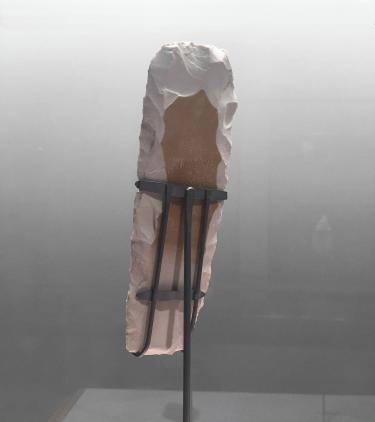Two graduate students win honorable mentions in the International Sculpture Center’s 2016 Outstanding Student Achievement in Contemporary Sculpture Award
University of Colorado Boulder graduate art students Benjamin McQuillan and Carissa Samaniego took home honorable mentions this summer for their sculptures from the International Sculpture Center’s (ISC) 2016 Outstanding Student Achievement competition.
Just 23 honorable mentions were awarded among 376 students from 148 colleges and universities. Both students, who study in CU Boulder’s sculpture and post-studio practice program, will be featured in the October 2016 issue of ISC’s Sculpture Magazine and on ICS’s website, www.sculpture.org.
McQuillan’s work is a collection of artifacts that resemble ancient tools made by shaping, or what’s called “flintknapping,” discarded porcelain toilets.
“It took me six months and a box of Band-Aids to get the tools into forms I liked,” McQuillan said. “I watched hours of YouTube videos to learn how to flintknap; there are a ton of people who’ve perfected the skill, mostly amateur anthropologists and reenactors.”
McQuillan said the idea behind his sculptures was to combine ancient survivalist principles and tools with those of the contemporary world like planned obsolescence, landfills, overpopulation and hoarding resources.
A sculpture by Benjamin McQuillan that employs “flintknapping.” Photo courtesy of Benjamin McQuillan.
“It’s about considering the impact of the Anthropocene [when humans began having a significant effect on ecosystems],” McQuillan said. “There’s a lot of talk about the impending apocalypse and our implication in bringing it about, so I find the idea of reintroducing the practices of conservation and working with the materials and tools around us very fascinating.”
Monika Burczyk, a judge for the ISC competition, said McQuillan’s work charmed her. “The display and the use of porcelain bathroom fixtures struck me as witty, thought-provoking and conceptual in a very sophisticated way,” Burczyk said.
McQuillan, a Nebraska native, said he’s flattered by the recognition and hopes it inspires discussion about the Anthropocene. “I also like the idea of more people being inspired to see new utilities in our waste. Modern bushmen and women running around foraging and living off the land, a land we have shaped. How might we have designed it differently if we knew we would be foragers once again?”
Samaniego said her pieces, which included a chandelier made from steel and cast porcelain and an automobile’s bench seat covered in gold leaf, “explore where place and identity intersect” by using objects and bricolage from places where she grew up: rural areas in Colorado, Minnesota and New Mexico.
“I’m interested in sifting through my own experience of memory, tradition and place as a point of departure to make artwork that creates a dialogue about growing up mixed —, geographically, ethnically — and how that experience shapes the cultural history we’re building today,” Samaniego said.
Sculpture by Carissa Samaniego explores "where place and identity intersect” by using objects and bricolage from places where she grew up: rural areas in Colorado, Minnesota and New Mexico. Photo courtesy of Carissa Samaniego.
Emily Nelms Perez, an ISC judge and New Jersey-based sculptor, said she experienced an emotional reaction to Samaniego’s work. “I instantly sensed the sensitive nature and storytelling aspect behind the chandelier,” Perez said. “There was a delicate nature, simplicity and craftsmanship to her work.”
Samaniego said earning honorable mention is valuable, particularly for an emerging artist. “Sometimes being at school in Colorado can feel disconnected from the major art centers, [but] I don't believe you need to be in New York City or London to make important work,” Samaniego said. “It feels good to have your work be recognized, especially when your work is about outsider places like mine.”
Valerio Ferme, associate dean for arts and humanities at the College of Arts and Sciences, said McQuillan and Samaniego’s recognition in an international competition attests to both the quality of their work and the faculty’s ability to attract top students.
“This encourages even more quality students to join our graduate programs in the arts,” Ferme said.
“We think highly of our art program colleagues, and it’s exciting to see them have success — they continue to show that investment in the arts pays off. I think a healthy art department is vital to ensure that CU Boulder continues to show itself as a sustaining, vibrant and diverse educational provider.”
McQuillan is in his final year and is applying for teaching positions and residencies. “I’m lucky to have a ton of support back in my hometown and here in Colorado, but I’d also like to see more of the world and other artist communities.”
Samaniego entered her third year this fall. “I've still got nine months to figure out the post-graduation question,” she said.







